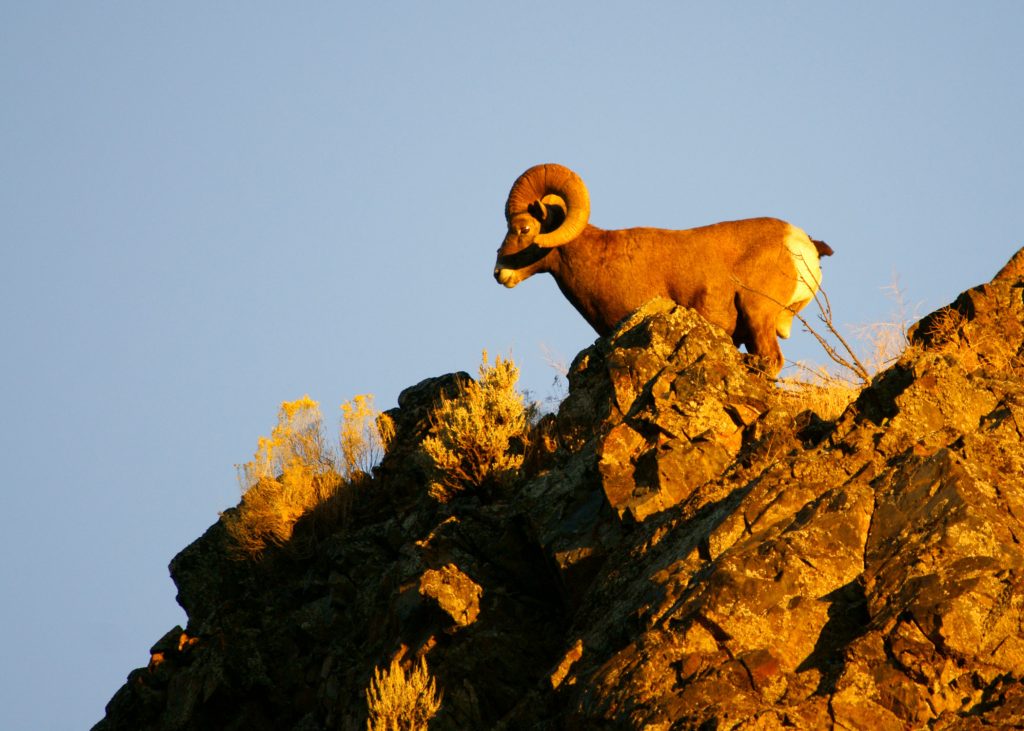
WDFW Asks Public For Reports Of Sick Bighorns In Quilomene As Biologists Also Monitor Herd
WDFW will continue to monitor a Central Washington bighorn herd after disease tests on 12 came back negative and is also asking the public to report any coughing or unusual behavior they see among the wild sheep.

“Because of the severity of this disease to bighorn populations, we’re on high alert for any abnormal behavior in the Quilomene,” said Mike Livingston, the state agency’s regional director, in a press release. “And, if we’re able to capture and test a few animals, that may bolster additional confidence in these negative results.”
Plans call for WDFW to perform systematic helicopter searches, which will give biologists the chance to assess the health of the herd as well as live-capture animals for additional testing.

And hunters, hikers and others who see sick sheep around Vantage, Gingko Petrified Forest State Park, the Quilomene Wildlife Area and nearby lands are being asked to “immediately” contact WDFW.
Earlier this week WDFW had to lethally remove nine rams – including six adults – and three ewes after a domestic sheep was observed with seven bighorns near Hole in the Wall in late September.
Testing on that sheep Oct. 6 revealed it carried Mycolplasma bacteria, known to give bighorns pneumonia, which is often fatal and can have effects that last for years in wild herds.
To head off the spread in the past WDFW has had to eradicate dozens of bighorns – even an entire herd once to protect nearby groups. A 2019 letter from environmental groups to the U.S. Forest Service claims that that herd, the Tietons, can’t be reestablished “due to the existing threat of disease” from domestic sheep grazing. The range was close to the Cleman Mountain Herd.
The negative results on the 12 Quilomene bighorns was “hopeful news,” according to Livingston.
He also addressed pushback on why those animals had to be killed if they ultimately were uninfected.
“We decided to lethally remove and test animals that were at the highest risk of being infected based on their proximity to the ewe,” Livingston said.
This is also the start of the bighorn breeding season, which sees rams wandering in search of mates, a possible disease vector.
Meanwhile, the situation is also being very closely watched by hunters and wildlife advocates. Five Quilomene ram permits were available this season, the most of any herd in the state.
“It’s good news about the testing, but the follow-up monitoring they’ll need to do on the herd, including helicopter chasing to see if the Quilomene bighorns are coughing, is serious both for the agency and its resources and for the sheep themselves,” said Chase Gunnell of Conservation Northwest.
His organization has been working on sageland wildlife and habitats the past few years as well as increasingly scrutinizing bighorn issues.
“This incident and the pattern of disease exposure from domestic sheep to wild bighorns in Central Washington in recent years is confirmation that the status quo cannot continue, particularly considering the precarious baseline of Washington’s wild sheep population,” Gunnell said.
He said that Conservation Northwest would be calling on federal and state land managers to require that the sheep’s owner’s grazing leases include reporting missing animals.
“We hope a voluntary agreement can be reached to reduce disease risks from public lands grazing allotments,” Gunnell said.
This particular ewe had been lost since at least Sept. 13, two weeks before it was observed at Hole in the Wall by an off-duty county deputy.
One of the most isolated herds in the state, the Quilomene bighorns otherwise “would not be expected to experience a disease outbreak within 50 years,” according to a 2016 risk assessment done for the Okanogan-Wenatchee National Forest about the potential impact livestock on federal grazing leases could have on Central Washington’s wild sheep.
